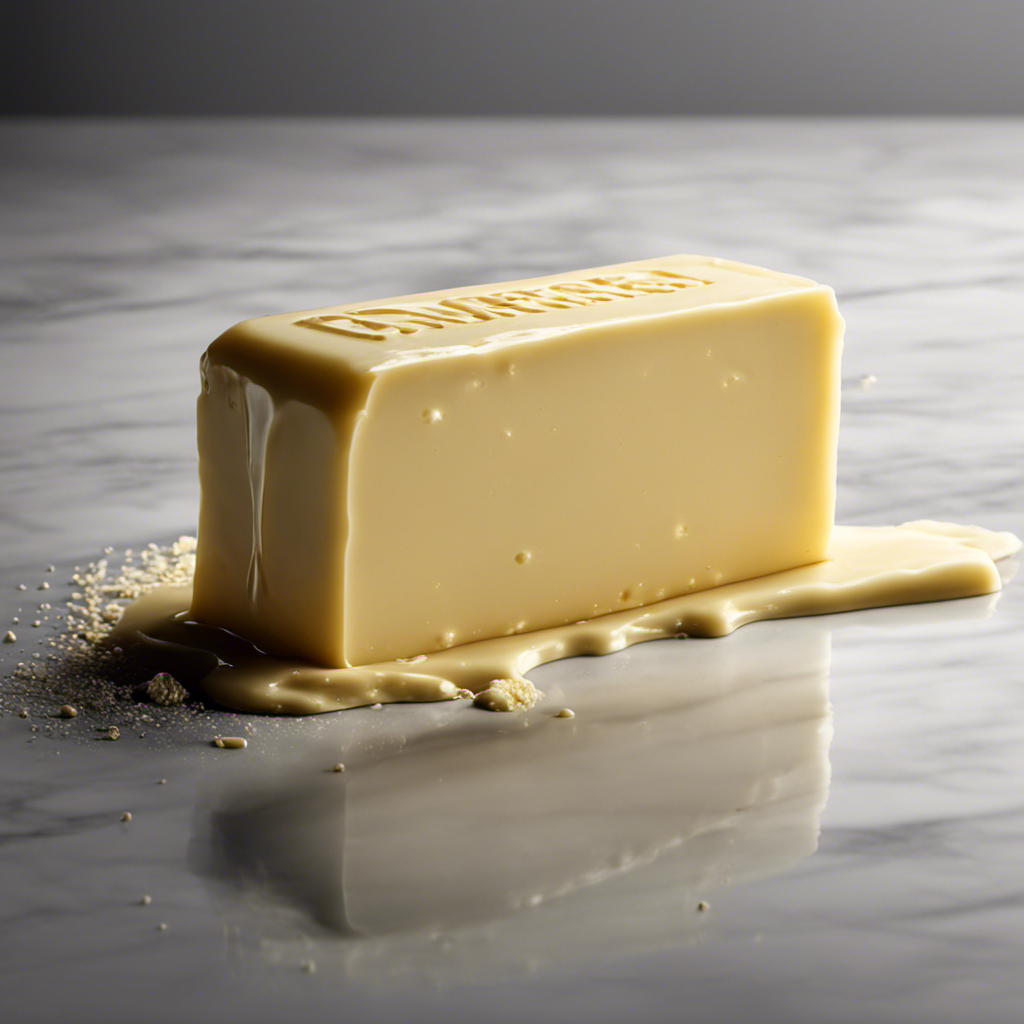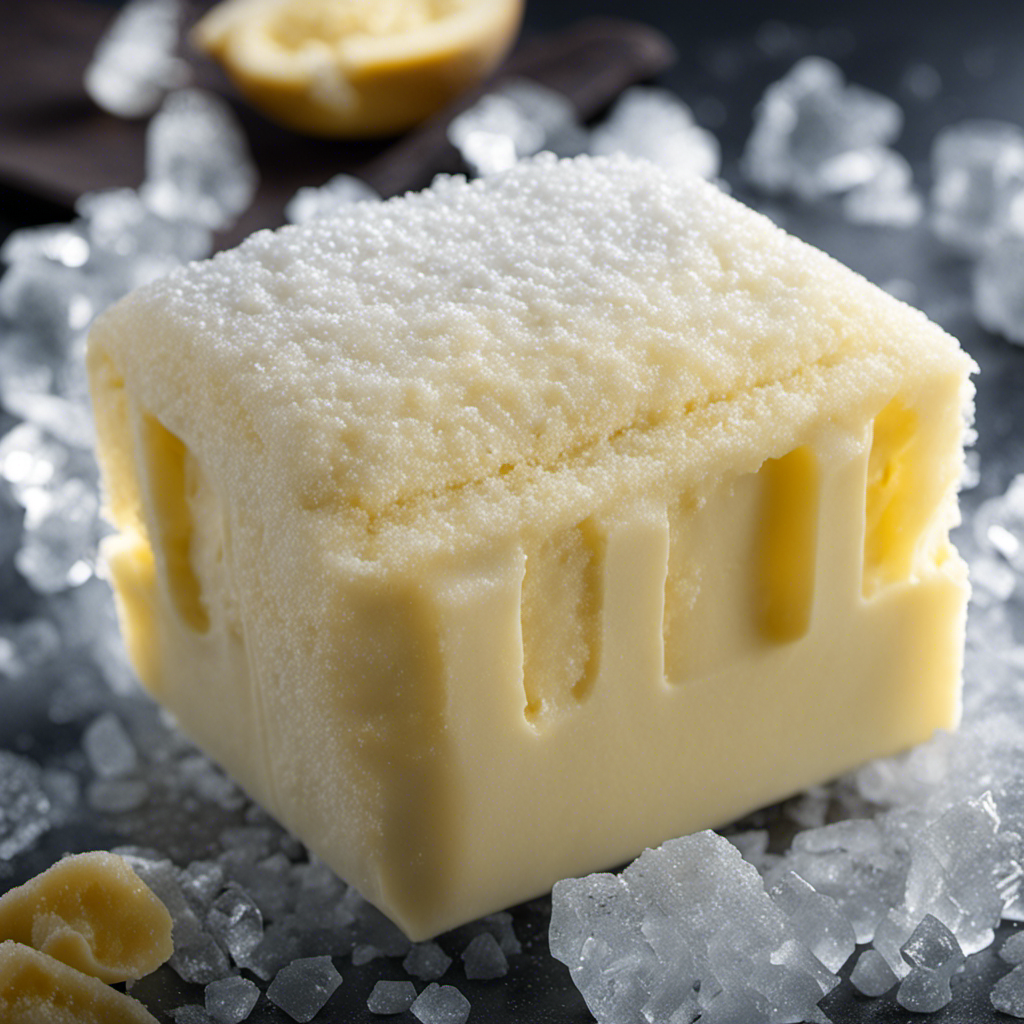As someone who loves baking, I understand the frustration of discovering spoiled buttercream frosting right when you’re about to enjoy a tasty treat. That’s why it’s important to know how long this delicious topping can be stored.
In this article, we’ll explore the factors that affect the shelf life of butter cream frosting, signs of spoilage to watch out for, and proper storage techniques to extend its freshness.
Get ready to savor your homemade creations for longer!
Key Takeaways
- Proper storage techniques, such as using an airtight container and refrigerating, can help extend the shelf life of butter cream frosting.
- Signs of spoiled butter cream frosting include discoloration, mold growth, and an off-putting smell.
- Factors such as temperature, exposure to heat, and bacteria and mold growth can affect the shelf life of butter cream frosting.
- To extend the shelf life of butter cream frosting, it can be used as a filling, frozen in an airtight container, thawed slowly, or repurposed for other uses.
Storage Guidelines for Butter Cream Frosting
I store my butter cream frosting in an airtight container in the refrigerator to ensure it stays fresh. Proper storage is essential to maintain the quality and taste of the frosting.
While butter cream frosting is a classic choice for cakes and desserts, there are alternative frosting options available. Some popular alternatives include cream cheese frosting, ganache, and whipped cream frosting. Each of these options has a unique flavor and texture that can complement different types of cakes.
Additionally, butter cream frosting can be made in various flavors to cater to different preferences. Some common flavors include vanilla, chocolate, strawberry, and lemon. Experimenting with different flavors can add excitement and variety to your baked goods.
Remember to always follow storage guidelines and use fresh ingredients to enjoy the best tasting butter cream frosting.
Factors That Affect the Shelf Life of Butter Cream Frosting
Typically, factors such as temperature and storage conditions affect how long butter cream frosting remains fresh. When it comes to the shelf life of butter cream frosting, there are several important factors to consider.
The first factor is temperature. Butter cream frosting should be stored in a cool environment, ideally between 40°F and 45°F, to maximize its freshness. Additionally, exposure to heat can cause the frosting to melt and spoil more quickly.
Another factor to consider is the storage container. Using an airtight container can help prevent air and moisture from seeping in, which can lead to the growth of bacteria and mold.
Lastly, freshness indicators such as discoloration, mold growth, or an off-putting smell should be carefully monitored to determine if the frosting is still safe to consume.
Signs of Spoiled Butter Cream Frosting
Stored in a cool environment, the butter cream frosting should be carefully monitored for signs of spoilage such as discoloration, mold growth, or an off-putting smell. These indicators may suggest that the frosting has become contaminated or has exceeded its shelf life.
To prevent spoilage, it’s important to understand the common causes and take proper precautions. Here are three key things to consider:
-
Temperature: Keep the frosting refrigerated at all times to slow down bacterial growth and extend its freshness.
-
Hygiene: Ensure that all utensils, surfaces, and hands are clean before handling the frosting to avoid introducing harmful bacteria.
-
Storage containers: Use airtight containers to prevent moisture and contaminants from entering the frosting.
How to Properly Store Butter Cream Frosting
To maintain the freshness of butter cream frosting, it’s crucial to store it in a cool environment and follow proper temperature guidelines. Here are some tips for properly storing butter cream frosting:
- Store the frosting in an airtight container to prevent it from drying out or absorbing odors from the refrigerator.
- Keep the frosting away from strong-smelling foods, as it can easily absorb odors.
- Place the frosting in the refrigerator, as it will last longer and maintain its consistency better in cooler temperatures.
Properly storing butter cream frosting will ensure that it stays fresh and ready to use for your cakes and desserts. By following these guidelines, you can enjoy the smooth and creamy texture of the frosting for longer periods of time.
| Tips for Decorating Cakes with Butter Cream Frosting | Different Types of Butter Cream Frosting Recipes |
|---|---|
| 1. Use a piping bag and various tips for different designs. | 1. American butter cream: made with butter, powdered sugar, and vanilla extract. |
| 2. Experiment with different colors and flavors for a personalized touch. | 2. Swiss meringue butter cream: made with egg whites, sugar, butter, and vanilla. |
| 3. Chill the cake before decorating to prevent the frosting from melting. | 3. Italian meringue butter cream: made with sugar syrup, egg whites, butter, and vanilla. |
| 4. Practice different techniques, such as rosettes, ruffles, and borders. | 4. French butter cream: made with egg yolks, sugar syrup, butter, and flavorings. |
| 5. Have fun and let your creativity shine! | 5. Vegan butter cream: made with vegetable shortening, powdered sugar, and non-dairy milk. |
Extending the Shelf Life of Butter Cream Frosting
I’ve found that placing butter cream frosting in the refrigerator helps maintain its freshness and texture. But there are other ways to extend the shelf life of this delicious treat. Here are a few tips and tricks I’ve learned:
-
Use leftover butter cream frosting as a tasty filling for cupcakes or donuts. It adds a burst of flavor and makes your baked goods extra special.
-
Freeze butter cream frosting in an airtight container for up to 3 months. When thawing, make sure to bring it back to room temperature slowly to prevent any texture changes.
-
Repurpose leftover frosting by spreading it on graham crackers or cookies for a quick and indulgent snack.
Frequently Asked Questions
Can I Freeze Butter Cream Frosting to Extend Its Shelf Life?
Yes, you can freeze butter cream frosting to extend its shelf life.
Freezing is a great alternative for preserving the frosting if you’ve extra or want to make it ahead of time.
Simply transfer the frosting into an airtight container, leaving a little space for expansion, and freeze it.
When you’re ready to use it, thaw it in the refrigerator overnight and give it a good whisk before applying.
Freezing helps maintain the texture and taste of the frosting for a longer period.
Can I Store Butter Cream Frosting at Room Temperature?
Storing butter cream frosting at room temperature can be risky due to the high fat content. It’s best to refrigerate it to prevent spoilage and maintain its freshness.
However, if you prefer to store it at room temperature, make sure to use it within a few days and keep it in a cool, dry place away from direct sunlight.
Alternatively, you can freeze butter cream frosting to extend its shelf life. Just be sure to thaw it properly before using.
Can I Reheat Butter Cream Frosting if It Becomes Too Hard?
If my butter cream frosting becomes too hard, I can definitely reheat it to soften it up. I usually use a double boiler or microwave to gently warm it until it reaches a spreadable consistency again.
It’s important to be careful not to overheat it though, as it can turn runny.
If reheating doesn’t work, I might consider using a different type of frosting, such as cream cheese or ganache, as an alternative.
How Long Can I Leave Butter Cream Frosting Out at a Party?
When it comes to storing butter cream frosting, it’s important to consider the effects of temperature.
At a party, it’s best not to leave the frosting out for too long, as it can spoil if not kept at the proper temperature. The length of time it can be left out depends on various factors such as the temperature of the room and the ingredients used.
It’s always safer to refrigerate the frosting to ensure its freshness and avoid any potential risks.
Can I Use Expired Butter Cream Frosting if It Looks and Smells Fine?
If it looks and smells fine, can I use expired butter cream frosting?
While it may be tempting, I’d advise against it due to safety concerns. Consuming expired food products can lead to foodborne illnesses.
Even if the frosting appears to be in good condition, there’s a chance that harmful bacteria may have grown.
To ensure your safety, it’s best to discard expired butter cream frosting and make a fresh batch.
Conclusion
In conclusion, proper storage is key to maximizing the shelf life of butter cream frosting. By following the recommended guidelines and ensuring it’s stored in an airtight container in the refrigerator, you can enjoy its deliciousness for up to two weeks.
Remember, the taste and quality may deteriorate over time, but don’t worry, it won’t turn into a moldy monster overnight!
So go ahead and savor every creamy, dreamy bite before it magically disappears!










